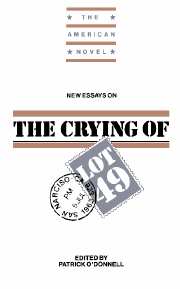Book contents
- Frontmatter
- Contents
- Series Editor's Preface
- 1 Introduction
- 2 Borges and Pynchon: The Tenuous Symmetries of Art
- 3 Toward the Schizo-Text: Paranoia as Semiotic Regime in The Crying of Lot 49
- 4 “Hushing Sick Transmissions”: Disrupting Story in The Crying of Lot 49
- 5 “A Metaphor of God Knew How Many Parts”: The Engine that Drives The Crying of Lot 49
- 6 A Re-cognition of Her Errand into the Wilderness
- Notes on Contributors
- Selected Bibliography
4 - “Hushing Sick Transmissions”: Disrupting Story in The Crying of Lot 49
Published online by Cambridge University Press: 12 January 2010
- Frontmatter
- Contents
- Series Editor's Preface
- 1 Introduction
- 2 Borges and Pynchon: The Tenuous Symmetries of Art
- 3 Toward the Schizo-Text: Paranoia as Semiotic Regime in The Crying of Lot 49
- 4 “Hushing Sick Transmissions”: Disrupting Story in The Crying of Lot 49
- 5 “A Metaphor of God Knew How Many Parts”: The Engine that Drives The Crying of Lot 49
- 6 A Re-cognition of Her Errand into the Wilderness
- Notes on Contributors
- Selected Bibliography
Summary
“The sight of sawdust, even pencil shavings, made [Mucho Maas] wince, his own kind being known to use it for hushing sick transmissions” (13). Although this image of consumerist deception appears on its face simply to be a symptom of Mucho's inability “to believe in” the used car lot where he once worked, it uncovers for us a matrix of transmissions beyond the doctored gear boxes of beat-up Chevrolets. In automobiles, a transmission is the linkage necessary for transferring power into positive motion. If the gear box has been “doctored” (paradoxical jargon for “contaminated”) with sawdust, it cannot communicate its decay on the way to breakdown — the sawdust disrupts both communication, and ultimately, the transfer of power. Such a deception seems to define an America out of touch with its “founding” commercial values of integrity and truth-in-lending, and it hints at a key element of inquiry Thomas Pynchon pursues in The Crying of Lot 49: How does a culture or society transmit a heritage — its ideals or its corruptions — and how are these transmissions disrupted?
This fundamental question, however, suggests further questions that Pynchon wants his readers to ask: What are our cultural transmissions? How are cultural patterns valorized by a society formed from precursor social structures? How are these patterns produced to meet local needs for order and control? How do they establish a status quo that strives always to reproduce itself and, thus, to ensure the unencumbered transmission of sociocultural formations to the next generation? When asking these questions we must remember that cultural and social formation always implies the construction of a social hierarchy, complete with myths of power and privilege.
- Type
- Chapter
- Information
- New Essays on The Crying of Lot 49 , pp. 79 - 96Publisher: Cambridge University PressPrint publication year: 1992
- 2
- Cited by



